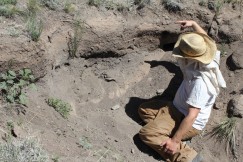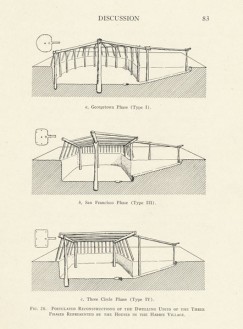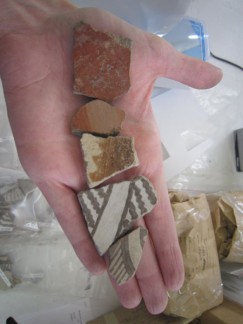- Home
- >
- Preservation Archaeology Blog
- >
- Even Farther Underground: The Pithouses of Mule Cr...
 |
By Katherine A. Dungan, Research Assistant
|
As you know from previous posts, our work in the Upper Gila focuses on the Kayenta and Salado migrations of the late 13th through mid-15th centuries and on the 13th century occupation at the Fornholt site, where we worked this past summer. Mule Creek’s archaeological record stretches back even further, however.

Archaic projectile points provide evidence that people inhabited or passed through Mule Creek at least 3,000 years before the founding of the 13th century settlement at Fornholt. People lived in Mule Creek, at least intermittently, from the Archaic period through the Classic Mimbres phase (A.D. 1000–1150), as well as in the 13th through 15th century periods that we study.
In this post, I’m going to share information about one part of this long history: the Late Pithouse period (c. A.D. 550–1000). Pithouses are on my mind because I’m finishing an analysis of ceramics from Gamalstad, where we excavated in 2009. At Gamalstad, it looks like a small Salado settlement was founded on top of a smaller Classic Mimbres phase (that is, Mimbres Pueblo period) settlement and a substantial Late Pithouse period settlement. Although our largest sample of Late Pithouse period ceramics comes from Gamalstad, all three of the sites in Mule Creek where we’ve carried out excavations—and many or most of the small sites that we’ve seen elsewhere in the valley—also have a Late Pithouse period component.

Pithouse architecture can be very hard to see on the surface of a site, although the remains of pithouses are sometimes visible as shallow depressions. Many such depressions are visible, for example, south of the larger room block at Fornholt. Excavated sites in the larger Mimbres/Mogollon region—such the Harris Site, where Emil Haury excavated in the 1930s and Dr. Barbara Roth of the University of Nevada Las Vegas is currently excavating—give us a good idea of what Late Pithouse period architecture would have looked like. These were semi-subterranean structures with elaborated entryways. In the early part of the period (the Georgetown Phase, c. A.D. 550 to 650), pithouses were round or D-shaped, becoming rectangular in the subsequent San Francisco (A.D. 650 to 750) and Three Circle Phases (A.D. 750 to 1000).
Our best evidence for Late Pithouse period settlement in Mule Creek comes from diagnostic painted ceramics, including Mogollon Red-on-brown, which was produced during the San Francisco phase, and Three Circle Red-on-white and Mimbres Black-on-white Style I (also called Boldface), which were produced during the Three Circle phase. Mimbres Black-on-white Style II (also called Transitional) straddles the transition between the Late Pithouse period and the Mimbres Classic phase, when above-ground architecture appeared throughout the Mimbres area.

All of these types are present in at least small numbers from 3-Up and Gamalstad, and all but Three Circle Red-on-white appear in the analyzed assemblage from Fornholt. We can therefore conclude that all three sites were definitely inhabited during the San Francisco and Three Circle Phases. It’s likely that Mule Creek was settled during the earlier Georgetown Phase, as well; because the primarily plain brown or red-slipped ceramics made during this time period continued to be made during later phases, it’s very difficult to see evidence for this time period in our mixed ceramic assemblages.
Although our primary research focuses on Mule Creek’s later residents, these ceramics provide a tantalizing glimpse into the (literally!) deeper history of Mule Creek. Pithouse Period people clearly found Mule Creek an attractive area in which to make a home, centuries before the construction of the Tularosa and Cliff Phase settlements we study.
For an excellent overview of Mimbres archaeology, focusing primarily on the Mimbres Classic, check out Mimbres Lives and Landscapes (from SAR Press, edited by Margaret Nelson and Michelle Hegmon).
Explore the News
-
Join Today
Keep up with the latest discoveries in southwestern archaeology. Join today, and receive Archaeology Southwest Magazine, among other member benefits.
One thought on “Even Farther Underground: The Pithouses of Mule Creek”
Comments are closed.